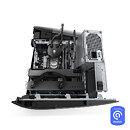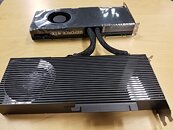Monday, May 18th 2020

Asetek Unveils Rad Card Industry's First Slot-In PCIe Radiator Card
Asetek, the creator of the all-in-one (AIO) liquid cooler and the global leader in liquid cooling solutions for gaming PCs and DIY enthusiasts, today announced its Rad Card GPU Cooler, bringing liquid cooled GPUs to space constrained PC cases. Asetek's Rad Card GPU Cooler, the industry's first slot-in PCIe radiator card, is first available in Dell-Alienware's newly introduced Alienware Aurora R11 PC.
Space concerns are a real issue for PC manufacturers, leaving GPU air cooling as the only option, until now. Asetek took this challenge head-on, innovating a new approach to radiator technology that reimagines the shape and location of the radiator. The Asetek Rad Card GPU Cooler fits into your motherboard's PCIe slot, just like any other add-in card. By utilizing PCIe slots, Asetek has defined a way to overcome PC manufacturers' dilemma of finding additional space inside the case for a liquid cooled GPU heat exchanger (HEx).
Update May 18th: This card may not be limited to just OEMs with Asetek tweeting "Not all of them made it to Alienware. Not what to do with these...". Asetek is very open about seeking feedback and is watching demand for this product from consumers, possibly even getting ready for a giveaway so it will be exciting to see what comes from this.The unique design of Asetek's Rad Card GPU Cooler provides numerous benefits:
Sources:
Asetek, @Asetek
Space concerns are a real issue for PC manufacturers, leaving GPU air cooling as the only option, until now. Asetek took this challenge head-on, innovating a new approach to radiator technology that reimagines the shape and location of the radiator. The Asetek Rad Card GPU Cooler fits into your motherboard's PCIe slot, just like any other add-in card. By utilizing PCIe slots, Asetek has defined a way to overcome PC manufacturers' dilemma of finding additional space inside the case for a liquid cooled GPU heat exchanger (HEx).
Update May 18th: This card may not be limited to just OEMs with Asetek tweeting "Not all of them made it to Alienware. Not what to do with these...". Asetek is very open about seeking feedback and is watching demand for this product from consumers, possibly even getting ready for a giveaway so it will be exciting to see what comes from this.The unique design of Asetek's Rad Card GPU Cooler provides numerous benefits:
- Space: Rad Card enables a liquid cooled GPU in a chassis where space is constrained, while leaving room for a liquid cooled CPU in the same case.
- Performance: In space constrained PC cases, Rad Card provides superior cooling over an air-cooled GPU, ensuring GPU stability and limiting thermal throttling.
- Aesthetics: Rad Card eliminates the hassle and clutter of tube routing for a clean and sparse system environment.




59 Comments on Asetek Unveils Rad Card Industry's First Slot-In PCIe Radiator Card
How much you wanna bet a 4 slot aircooler with 2x 120x25mm fans will smoke this. Oh wait this thing 5 slotted due to the tubings... so versus 2x Delta fans hahaha!
Look today where is cpu colliers air cooler and aio.
Either way, they were all already beat to the punch by the www.techpowerup.com/review/thermaltake-tide-water/
hexus.net/tech/reviews/graphics/8553-asus-en8800gtx-aquatank-fastest-graphics-card-world/?set_mobile_full_site_cookie=1
Giving Sapphire credit for the concept is one thing but saying Aseteks design is a ripoff of theirs is like saying the occulus quest is a ripoff of the virtual boy.
This is also going to be worse than a regular radiator to get rid of the heat and that blower fan, just urgh...
@ppn makes sense, but my first thought is weight. I mean how much you can strap on that GPU's PCB? Radiator, pump, separate VRM cooling, actual fan, etc, etc. Gonna be a pretty hefty load on that four screws.
The products that we had 10+ years ago woud'nt fit properly these days on "newer" cards, and their cooling capacity does'nt even come close to today's standards. If you have a properly vented case, really the heat is'nt a problem. Water takes heat away faster and more efficient then a huge copper/alu air cooled block would do.
Here's my answer to stuffing op a AIO CPU cooler onto a GPU.
But happy to see that another attempt is being made at this type of device. :)
I'm interested to see how they address VRM cooling within that fan housing/shroud.
I'm not "most people" though. That would be my media center PC which is the standard single card like almost every prebuilt and PC build-guide out there.